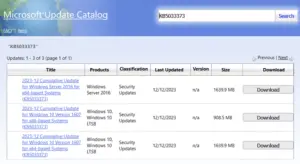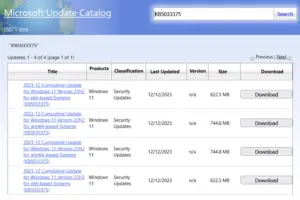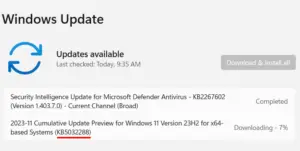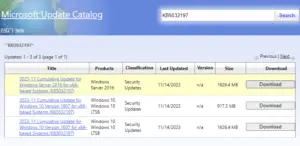Microsoft releases non-security updates KB4550969 and KB4550944 for Windows 10 1800 OS build versions. They update the Windows 10 1809 operating system to Build 17763.1192 and 1803 to 17134.1456. KB4550969 works upon several pending issues that occur due to either logman.exe, LsaIso.exe, or WDF01000.sys.
Moreover, this addresses several BSOD error codes such as – 0x18, 139, and 0x3B. Similarly, KB4550944 improves the DataGridView cell issue, 0xC0000005, and several others. This time, you won’t be able to get these patch updates through the Windows Server Update Services (WSUS). However, you can download/install the standalone package manually for these visiting the Update-Catalog. Let’s explore the new fixes and features in detail –
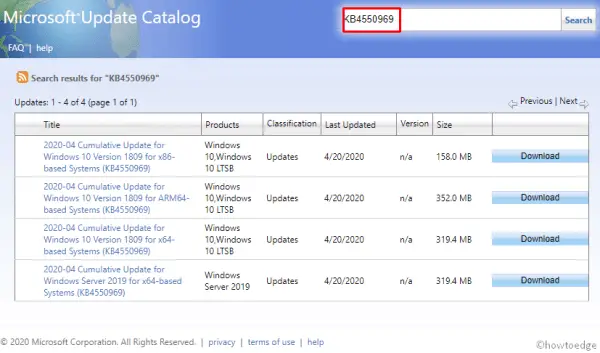
KB4549949 and KB4550944 – Changelogs
The key changes on KB4550969 and KB4550944 non-security patch update are as follows –
KB4549949
- Resolves a bug that occurs when a third-party application loads hidden tabs into Internet Options.
- KB4550969 addresses an issue that prevents pasting mixed content of images and text from Microsoft Word into Internet Explorer.
- Works upon an anomaly that causes a box containing multiple lines of text to stop responding in certain scenarios.
- DataGridView cell may now recognize the first keystroke after applying this patch update.
- Earlier, the application using msctf.dll stops working and results in an error code 0xc0000005. The company addresses this bug as well.
- Improves the reliability issue in WDF01000.sys.
- Addresses issues that occur due to logman.exe, LsaIso.exe, etc.
- Resolves a bug that restricts users from setting the REG_EXPAND_SZ keys in some automated scenarios.
- Solves the underlying causes behind the KERNEL_SECURITY_CHECK_FAILURE stop error code 139.
- The Merge-CIPolicy PowerShell command will not fail while using Windows Defender policies that sometimes generate a duplicate rule ID error.
- Works upon an issue that stops Microsoft Internet Information Services (IIS) management tools, such as IIS Manager, from managing an ASP.NET app configured to SameSite cookie settings in web.config.
- Resolves an error that causes the Event Viewer Microsoft Management Console (MMC) to stop working when the secondary monitor is above the primary monitor. An out of bounds exception appears.
- Rectifies an anomaly that prevents hash signing using the Microsoft Platform Crypto Provider for TPMs from working correctly. This issue might also affect networking software, such as VPN applications.
- Addresses an issue that prevents a user’s PIN from being changed after connecting the device to Microsoft Workplace Join.
- Resolves a bug that restricts apps running in an Azure Active Directory environment from receiving account change notifications. This occurs when using the Web Account Manager (WAM) and the WebAccountMonitor API.
- Addresses an issue that fails to print content that is outside of the margins of a document.
- Resolves an issue that causes high CPU usage on Active Directory (AD) domain controllers when migrating to Windows Server 2019. This increases latency in Microsoft Exchange operations, causes Managed Store contention, and severely impacts index creation in Active Directory and the Global Catalog’s performance.
- Works upon an issue that logs incorrect Internet Protocol (IP) addresses in the audit logs because of missing or old data for active requests coming from “windowstransport/usernamemixed/certificatemixed” endpoints.
- Addresses an issue that causes devices that are provisioned for Windows Hello for Business (WHfB) to fail. Registration occasionally fails, which leads to a delay in WHfB enrollment and, in some instances, creates Conflicting Objects (CNF) in the Active Directory “Registered Device” container.
- Corrects the deadlock issue while using the Remote Desktop Gateway service.
- Fixes the 0x3B stop code wherein the system stops to work when running a binary that is signed by a revoked certificate.
- Addresses an issue that prevents the Notification State registries from being deleted for certain apps even after the user profile is deleted.
- Resolves the BSOD error 0x18 (REFERENCE_BY_POINTER) when Remote Desktop sessions redirect devices that are not input devices.
- Addresses an issue that displays a black screen to Windows Virtual Desktop users when they attempt to sign in.
Known Issues
The company didn’t address the persisting error “0x800f0982” after installing KB4493509. Rather, they have provided a temporary solution which is as follow –
Uninstall then re-install the Asian language packs may help to fix this issue. If not, reset your computer by visiting the Settings app > Recovery. While doing so, make sure to tick the “Keep my files” checkbox.
KB4550944
- Resolves an issue that occurs when a third-party application loads hidden tabs into Internet Options.
- Works upon an issue with pasting mixed content of images and text from Microsoft Word into Internet Explorer.
- Improves the DataGridView cell issue so that the first keystroke gets recognized easily.
- Addresses an issue that causes an error in logman.exe. The error is, “A user account is required in order to commit the current Data collector Set properties.”
- Resolves a bug that prevents users from setting the REG_EXPAND_SZ keys in some automated scenarios.
- Addresses an issue that causes a memory leak in the LsaIso.exe process.
- Improves an anomaly with running klist.exe that causes lsass.exe to stop working and generates an access violation error (0xC0000005).
- Addresses a bug with merging Windows Defender Application Control policies that sometimes generates a duplicate rule ID error and causes the Merge-CIPolicy PowerShell command to fail.
- Works upon an issue that prevents applications running in an Azure Active Directory environment from receiving account change notifications. This occurs when using the Web Account Manager (WAM) and the WebAccountMonitor API.
- Resolves the Task Manager CPU frequency display issue that locks to the base frequency on devices equipped with certain CPUs.
- Addresses an anomaly that stops Microsoft Internet Information Services (IIS) management tools, such as IIS Manager, from managing an ASP.NET application configured to SameSite cookie settings in web.config.
- Addresses an issue that occurs when you try to sign in to Windows during recovery mode. The error, “No administrator accounts are available on this machine”, appears.
- Resolves an error that prevents you from removing some local users from local built-in groups. For example, you cannot remove “Guest” from the “Guests” local group.
- Addresses an issue that prevents certain apps from installing if you publish them using a Group Policy Object.
- Modifies a bug that causes Microsoft Edge to stop working if you attempt to use paste functionality on webpages when cut-and-paste functionality has been disabled using a policy and Windows Defender Application Guard is active.
Known Issues
As of now, Microsoft is not aware of any known issues on this Tuesday patch.
How to Download/Apply KB4550969 and KB4550944
Before proceeding to download and install the LCU for Windows 10 1800 series, make your system compatible with its servicing stack updates. Doing so will ensure the smooth update process. The respective SSUs are as follows –
Now, you can head over to the below channels and download the non-security patch updates for 1809 & 1803.
- Windows Update – You will receive a message regarding an upgrade to the KB4550969 and KB4550944 on the notification panel.
- Standalone Package – Windows 10 1800 users may download and install the .msu files manually as well. The direct links are –
Imp: Just make sure to check the system architecture before clicking on the Download button.
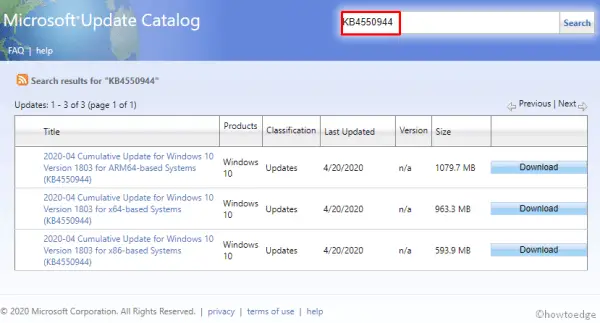
Note: This time, you can’t download these security patches via Windows Server Update Services (WSUS).
